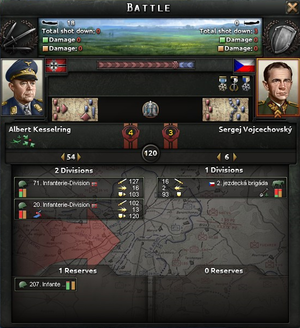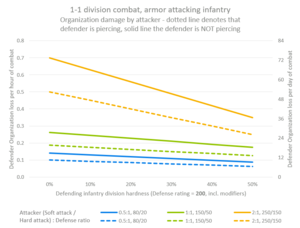小 (→伤害结算: in half a day 半日后……) |
(→战斗宽度) |
||
| 第10行: | 第10行: | ||
==战斗宽度== | ==战斗宽度== | ||
在战斗中,每个师的战斗宽度将被相加在一起,以确定有多少个师与前线宽度相适应并参加战斗 | 在战斗中,每个师的战斗宽度将被相加在一起,以确定有多少个师与前线宽度相适应并参加战斗 。 多线进攻时,战斗的可用宽度会增加,所以当战斗宽度是部队进攻的限制因素时,需要多线进攻以增加战斗宽度 。 战斗宽度也受特定的战术影响. 战场的基本战斗宽度是{{green|80}} , 每个额外的进攻方向将增加{{green|40}}战斗宽度 。 | ||
师的作战宽度是所有营的宽度之和。步兵营(包括摩托化步兵、机械化步兵和特种部队)、坦克营和反坦克营的作战宽度是2,炮兵营和自行火炮营(SPG)的作战宽度是3,反坦克营、防空营的作战宽度是1。支援连不占用作战宽度。 The Vast Offensives and Human Wave Offensive technologies from mutually exclusive branches of the Mass Assault doctrine tree reduce the width of ordinary infantry battalions by 0.4, meaning 25% more infantry battalions can fit in the same infantry frontage. | |||
Divisions will be added from the reserve unless the combat width penalty exceeds 33%. The combat width penalty is calculated as 2 * (total_width - battle_width) / battle_width, so this shows that in a 80-width battle, it is possible to have a 93 width (penalty of 32.5%), but not a hypothetical width of 94 (penalty of 35%). | Divisions will be added from the reserve unless the combat width penalty exceeds 33%. The combat width penalty is calculated as 2 * (total_width - battle_width) / battle_width, so this shows that in a 80-width battle, it is possible to have a 93 width (penalty of 32.5%), but not a hypothetical width of 94 (penalty of 35%). | ||
2021年3月18日 (四) 08:38的版本
A land battle is resolved in one hour turns, where both the attacking and defending divisions each randomly choose an opposing division to fight against this turn. In the following we refer to as the "attacker" the side who is on the offensive and initiated the battle and as "defender" the side which was attacked. A specific attacking and defending unit then depends on the combat phase and can refer to unit on either side.
Tactics
- 主条目:Combat tactics
Tactics are chosen at the start of combat and changed every 12 hours.
战斗宽度
在战斗中,每个师的战斗宽度将被相加在一起,以确定有多少个师与前线宽度相适应并参加战斗。多线进攻时,战斗的可用宽度会增加,所以当战斗宽度是部队进攻的限制因素时,需要多线进攻以增加战斗宽度。战斗宽度也受特定的战术影响. 战场的基本战斗宽度是80,每个额外的进攻方向将增加40战斗宽度。
师的作战宽度是所有营的宽度之和。步兵营(包括摩托化步兵、机械化步兵和特种部队)、坦克营和反坦克营的作战宽度是2,炮兵营和自行火炮营(SPG)的作战宽度是3,反坦克营、防空营的作战宽度是1。支援连不占用作战宽度。 The Vast Offensives and Human Wave Offensive technologies from mutually exclusive branches of the Mass Assault doctrine tree reduce the width of ordinary infantry battalions by 0.4, meaning 25% more infantry battalions can fit in the same infantry frontage.
Divisions will be added from the reserve unless the combat width penalty exceeds 33%. The combat width penalty is calculated as 2 * (total_width - battle_width) / battle_width, so this shows that in a 80-width battle, it is possible to have a 93 width (penalty of 32.5%), but not a hypothetical width of 94 (penalty of 35%).
Reserves
Divisions that do not fit the combat width or that join the combat after it has already started end up in reserves. While in reserve, these units do not contribute to the battle in any way, do not regain organization and do not increase their entrenchment or preparation bonuses.
Units in reserve have a chance to join combat every hour as long as there is combat width available. The base chance to join is only 2% per hour (so mean time to join is about 35 hours). This chance is greatly improved by having Radio researched, by division speed, doctrine tech, and having a signals company attached to the division.
When defending, if all frontline divisions retreat while there are still reserves available, the reserves are forced to retreat as well. Same for attacking—the attack stops if all frontline divisions run out of organization even if there are fresh reserves available.
As a defender, try providing reserves in a timely manner so they have time to reinforce the frontline and are not forced to retreat and potentially be overrun. If fighting at full width with fresh reserves, consider manually retreating your defending units that are very low on organization one at a time one province away from the front so they can recover and reserves can fill in. Otherwise, you run a risk that all frontline troops get low on organization and retreat at the same time, giving reserves no chance to reinforce.
If you are on the attacking side, consider not attacking with more units than can fit into combat width so that the rest, instead of waiting in reserve, can recover organization and gain the planning bonus. When you do have reserves and width available (if they caught up, or a division runs out of organization) and all defender units are already fighting, instead of waiting for reinforcement, it can be useful to stop the combat and attack again so all your units join immediately.
Attacks
Soft attacks and Hard attacks give the number of attacks against a defending division. The Hardness stat of the defending division determines the proportion of soft and hard attacks the division receives: For example, a division with 100% Hardness receives all Hard attacks and none of the Soft attacks and a division unit with 25% Hardness would receive 25% of the Hard attacks and 75% of the Soft attacks.
If the attacking division has lower piercing value when compared to defenders armor value, only half of the attacks are used.
The number of attacks is compared to number of defenses of the defending division before calculating the possible damage, see following section on Damage dealing.
Defenses
The attacker's Breakthrough values are used to determine how many defenses each of the attackers' units has. This is compared to the defenders' units hard and soft attacks to evaluate damage done to the attackers' units.
The defender's Defense values are used to determine how many defenses each of the defenders' units has. This is compared to attackers' units hard and soft attacks to evaluate the damage done to the defenders' units.
伤害结算
In damage dealing, the number of attacks is round(hardness modified attack / 10) and the number of defenses is round(defense / 10) (round(x) is random and defined as round(x) = ⌊x⌋ + Bernoulli(x - ⌊x⌋)). Both are integers.
每次进攻都有命中和未命中的可能,命中时会造成敌方HP和组织度受损。每次进攻过后,防守方单位移除1点防御值(若仍有剩余),而真正的命中几率取决于防守方有无防御值剩余。当一个单位有防御值剩余时,对攻击的基础躲闪几率为90%。如果防守单位已无剩余防御值,其躲闪几率降低至60%。
For each hit, the amount of possible damage done is random; a "die" is used to randomly choose the amount of damage done. For HP damage, the die size is 2 and for organization damage, it is 4. The exact amount of damage done to HP and organization per hit is calculated by multiplying the obtained die rolls with the damage modifiers (0.05 base modifier, tactics attack modifiers, and -50% when the target's armor is greater than the opponent's piercing). Other modifiers affect the number of attacks, thus the number of hits, but not the amount of resulting damage per hit.
When armored units are in combat against targets with insufficient piercing, the organization dice size is increased to 6, representing the ability of the armored unit to move more freely under fire, obtain better positioning and thus deal more damage. This means an unpierced armored unit on average does 3.5 organization damage per hit instead of 2.5, or 40% more damage per hit.
The damage done to a unit's HP reduces its manpower and equipment proportionally by HP loss percentage, in addition to equipment loss from attrition. The fighting strength of the unit is the minimum between the ratios of manpower and equipment IC. A unit's damage output is scaled by its fighting strength. The scaling is rounded to multiples of 10%, e.g., for strength less than 100% but greater or equal to 90%, the damage output is scaled by 90%. Note that damage done to a unit's HP does not change the other stats of the unit before the combat is finished.
举例说明上述机制:1个对人员杀伤1000的装甲师进攻,1个防御500的步兵师防守。
- 50次进攻受到抵抗;50次进攻未受抵抗。50 attacks against defense; 50 attacks against no defense.
- 50次进攻的命中几率为1 - 90% = 10%;50次进攻的命中几率为1 - 60% = 40%。
- 步兵师平均被命中50 * 0.1 + 50 * 0.4 = 25次。
- 计算组织度损失需要掷骰子25次,单次的数学期望为(1 + 6) / 2 = 3.5。
- 装甲师的战斗强度受损,略小于100%,故伤害输出向下修正至90%。
- 总结,装甲师预计每小时造成25 * 3.5 * 90% * 0.05 = 3.9点伤害。鉴于一个常规的步兵师的组织度为50-60,战斗预计将于半日后结束。
当一方有多个师参加战斗时,这些师可以将它们的杀伤值合并,以对抗防守方。例如,2个杀伤值100的师各自对单个防御值150的师。在此情况下,150点进攻“受阻”,有0.1的命中几率,而另外50点进攻“未受阻”,有0.4的命中几率。When more than one division participates from one side, they can combine their attack value to overcome the defense of the opposition. For example, two divisions with 100 attacks each pull their attacks versus single division with 150 defenses. In this situation 150 attacks will be considered "blocked" and have a 0.1 chance of hitting, while 50 attacks will be "unblocked" and have 0.4 chance of hitting.
Collateral damage
Infrastructure in the state and fortifications (naval fortifications for naval landings) in the province receive damage based on the attacker's attacks. The amount scales with the attacker's number of attacks, soft attack component and damage scaling factor. Damage against fortifications only occurs with a probability of 5% while infrastructure always gets damaged. Attacks by close air support do not cause collateral damage.
[math]\displaystyle{ \text{collateral damage} = 0.1 * \text{soft attack} * \#\text{ of attacks} * \text{damage dealing factor} }[/math][1]
The damage against infrastructure gets scaled further as described in Construction#Damage_and_repair.
![]() The Siege Artillery ability doubles both the probability and the damage against land forts.
The Siege Artillery ability doubles both the probability and the damage against land forts.
Combat factors
The following factors modify the number of attacks and/or defenses a unit has in combat (list is not exhaustive):
- Terrain: base penalties for attacker -20% in a forest, -30% in hills, -60% in mountains.
- River crossing: penalty of -30% or -60% for attacker attack and breakthrough depending on the river size
- Night: penalty of -50% for attacks of both sides
- Fort: penalty for attacker attack and breakthrough of -15% per fort level. Each extra attacking direction cancels out one fort level but not the last level.
- Encirclement: penalty for defender -30%
- Enemy air superiority: penalty for defender defense or attacker breakthrough.
penalty = enemy air superiority * (1 + enemy doctrine modifiers + terrain modifier + concealment advisor) * -0.35 + 0.7 * AA / (AA + 112)(the latter part is "enemy air superiority reduction"). - Low supply: scaling penalties up to -33% at no supply
- Exceeding combat width penalty: divisions in active combat can slightly exceed allowed combat width with a small penalty to offset this (-2% per extra combat width).
- Stacking penalty for having too many divisions in combat: (-2% per division over the stacking limit. The stacking limit is 8, plus 4 per flanking direction.
- In multiple combats: -50% for a division that is attacked from a different direction while already attacking
- Paradrop penalty: -30% combat penalty 48 hours after being paradropped.
- Amphibious penalty: -70%
- Commander skill, +5% per skill point for both attack and defense
- Planning bonus, the base maximum is +30% which can be further improved by a doctrine to +110%
- Entrenchment: +2% per each point built. Maximum achievable: 5 base + 11 engineer IV + 10 doctrine = +52%
- Air support: bonus to attack and defense (in addition to direct damage support planes do)
- Country bonus
- Division experience: -25% for green, 0 for trained, +25% for regular, +50% for seasoned and +75% for veteran
- Combat tactics
- Decryption advantage: +5% per decryption level compared to enemies average encryption level (ex: dec. level is 5 and enemy average enc. level is 3 then 5-3 = 2 which gives 10 % increase)
All positive factors stack with each other multiplicatively, so it is possible to reach very high values in a very good tactical situation.
For example:
- experience +75%
- entrenchment +40%
- terrain +20%
- country +40%
- commander skill +35%
Multiplied together this gives your unit +556% to base stats (1.75*1.4*1.2*1.4*1.35=5.56)
The final factor is capped at 1% if the multiplied value is lower.
Equipment damage
During combat, the ratios of equipment and manpower losses are updated to 70% of the loss in strength ratio. The stats of the unit are locked during the combat if the template is unchanged, and are updated after the combat.



